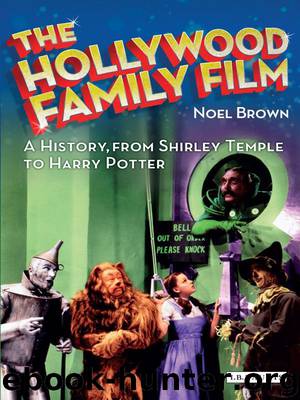Hollywood Family Film, The: A History, from Shirley Temple to Harry Potter (Cinema and Society) by Noel Brown

Author:Noel Brown [Brown, Noel]
Language: eng
Format: azw3
Publisher: I.B.Tauris
Published: 2012-09-18T04:00:00+00:00
Jason and the Argonauts (1963)
These reviews were written in a period in which poor plotting and characterisation were seen as standard weaknesses in juvenile-minded fantasy films, the assumption being, of course, that juvenile and adolescent audiences have not yet graduated to a higher plane of cultural awareness, borne through adult interpretative skills. It is only when such entertainment was also presented as suitable entertainment for adults that serious objections arose. Little wonder, then, that the film’s special effects were overlooked for Academy Award recognition. Unsurprisingly (in view of the lingering influence of middlebrow culture), the film that did win the Visual Effects Oscar in 1964 was the comparatively staid historical epic Cleopatra (Joseph L. Mankiewicz, 1963). Indeed, this lack of recognition is indicative of a wider industry disregard for Harryhausen, who was always forced to struggle for studio backing. Jason and the Argonauts was a commercial failure, and effectively ended Harryhausen’s and Schneer’s flirtation with the Hollywood mainstream. Their next ‘Dynamation’ film, First Men in the Moon (Nathan Juran, 1964) – adapted from H. G. Wells’s novel by respected British sci-fi writer Nigel Kneale – was one of their most intelligent productions, but it, too, was a flop. Harryhausen then made a profitable but critically-derided film for Hammer, One Million Years BC (Don Chaffey, 1966), while The Valley of Gwangi (Jim O‘Connolly, 1969) languished in obscurity.
Of the three major independent producers of family films during the late 1950s and 1960s, Robert B. Radnitz is the least remembered and perhaps the most interesting analytically, because his rise to prominence was so remarkable, and his eventual critical and commercial decline so precipitous. A former English teacher, Radnitz became a story consultant at Twentieth Century Fox during the 1950s, and managed to persuade his boss, production chief Buddy Adler, to allow him to produce a ‘straight’, low-budget adaptation of Ouida’s 1872 novel, A Dog of Flanders (James B. Clark, 1960). Like all of Radnitz’s productions, it was shot on location (in the Netherlands) with local actors, rather than in the studio. Although it was reasonably successful commercially, its critical reception was extremely positive. Furthermore, it won the Gold Lion (first prize) in the Children’s Film category at the Venice Film Festival – the first North American-produced recipient of the award. Variety observed:
At first, [the] leisurely pace [and] emphasis on character and background rather than the frantic action of today’s films, seems slow. But it has a beguiling warmth and credibility that builds a mounting interest and a cumulative effect. The 20th-Fox release proves that Disney needn’t have a monopoly on this sort of wholesome film fare.16
Radnitz produced a regular stream of simple but well-made family films along similar lines throughout the 1960s and early 1970s, all directed by Clark, including Misty (1961), Island of the Blue Dolphins (1964), And Now Miguel (1966), My Side of the Mountain (1969) and The Little Ark (1972). Over this period, Radnitz’s reputation grew rapidly among critics who appreciated his wholesome, unpretentious style, and also among opponents of Hollywood’s simultaneous embrace of youth- and adult-orientated entertainment.
Download
This site does not store any files on its server. We only index and link to content provided by other sites. Please contact the content providers to delete copyright contents if any and email us, we'll remove relevant links or contents immediately.
| Anthropology | Archaeology |
| Philosophy | Politics & Government |
| Social Sciences | Sociology |
| Women's Studies |
Cecilia; Or, Memoirs of an Heiress — Volume 1 by Fanny Burney(32437)
Cecilia; Or, Memoirs of an Heiress — Volume 2 by Fanny Burney(31873)
Cecilia; Or, Memoirs of an Heiress — Volume 3 by Fanny Burney(31857)
The Great Music City by Andrea Baker(31488)
We're Going to Need More Wine by Gabrielle Union(18972)
All the Missing Girls by Megan Miranda(15588)
Pimp by Iceberg Slim(14398)
Bombshells: Glamour Girls of a Lifetime by Sullivan Steve(13977)
Talking to Strangers by Malcolm Gladwell(13229)
Norse Mythology by Gaiman Neil(13211)
Fifty Shades Freed by E L James(13159)
For the Love of Europe by Rick Steves(13055)
Mindhunter: Inside the FBI's Elite Serial Crime Unit by John E. Douglas & Mark Olshaker(9206)
Crazy Rich Asians by Kevin Kwan(9170)
The Lost Art of Listening by Michael P. Nichols(7411)
Enlightenment Now: The Case for Reason, Science, Humanism, and Progress by Steven Pinker(7239)
The Four Agreements by Don Miguel Ruiz(6636)
Bad Blood by John Carreyrou(6557)
Weapons of Math Destruction by Cathy O'Neil(6148)
